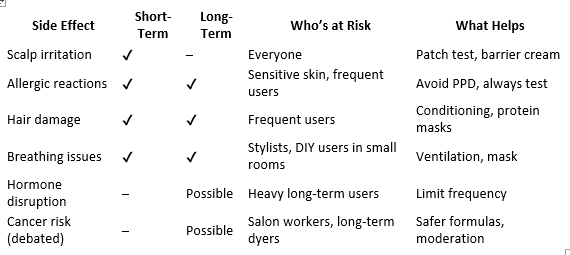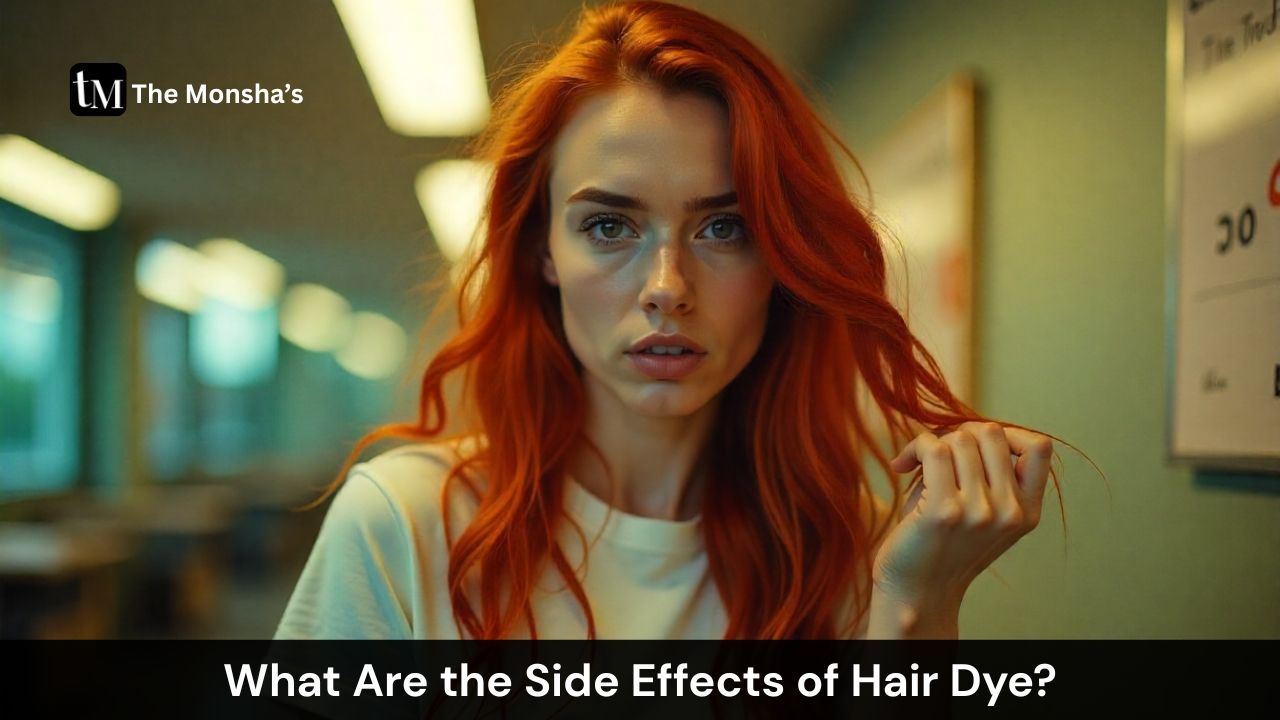I love a good hair color switch-up. There’s nothing like the confidence boost of walking out of a salon with glossy caramel streaks or finally covering up those stubborn greys. But here’s the part most blogs and even some stylists don’t tell you: hair dye comes with strings attached. Not just “oh my hair feels a bit dry” but sometimes real side effects that creep up on you over time.
I’ve dyed my hair for years (box dyes, salon foils, even a bad henna phase), and I’ve learned this the hard way: you don’t just dye your hair, you’re also signing a contract with your scalp, your lungs, and sometimes your health. Let’s break it down.
What’s Actually in Hair Dye?
- Ammonia – it pries open your hair cuticle so the new color can slip in. Think of it as crowbarring your strands open. Effective? Yes. Gentle? Absolutely not.
- Hydrogen Peroxide – this bleaches out your natural pigment. Necessary for blondes, brutal for moisture.
- PPD (Paraphenylenediamine) – common in dark colors, and the number one allergy culprit.
- Resorcinol and other extras – preservatives, fragrance, stabilizers… basically a cocktail your scalp didn’t ask for.
Even those “ammonia-free” dyes? Many use ethanolamine, which isn’t a saint either.
The Immediate Side Effects
- Itchy scalp – almost expected at this point. But no, it’s not “normal.” It’s irritation.
- Dryness and flaking – peroxide strips oils; your scalp cracks a little inside every time.
- Headaches or nausea – if you’ve ever dyed in a tiny bathroom with the fan off, you know.
- Random stains – ears, forehead, bathroom tiles… hair dye is basically modern art gone wrong.
I saw a study last year where about 4 in 10 frequent users said they had itching or burning every time they dyed. Most people brushed it off as “just part of the process.” It isn’t.
Short-Term Health Stuff People Ignore
- Allergic reactions – redness, swelling, even blisters. Usually PPD’s fault.
- Breathing irritation – especially for stylists around fumes all day.
- Weaker hair right away – the cuticle is roughed up from the first session.
This is why patch testing is non-negotiable. Yes, even if you’ve been dyeing for ten years. Allergies can show up randomly.
Long-Term Risks Nobody Likes Talking About
- Chronic allergies – once you develop one, you’re stuck with it. Each dye job after that can be worse.
- Asthma & breathing issues – salon pros deal with this constantly.
- Cancer debate – research is messy. Some studies say no big deal, others hint that long-term, heavy use of dark permanent dyes might up bladder cancer risks, especially for hairdressers. Not clickbait, just science trying to catch up.
- Hormone disruption (maybe) – some chemicals mimic hormones in lab tests. We don’t have solid human data, but it’s not comforting.
- Hair aging itself – bleaching and dyeing accelerates brittleness and dullness.
Everyday Damage Over Time
- Frizz that never quits
- Split ends multiplying like rabbits
- Thinning feel – your strands literally lose protein
- Fading faster each time – the cruel irony: damaged hair can’t even hold color well
Who Should Really Be Cautious?
- Pregnant women – most doctors say skip the first trimester at least.
- Teens trying their first dye – their scalps can be more reactive.
- Anyone with eczema or psoriasis – hair dye will likely make flare-ups worse.
Are “Natural” Options Any Better?
- Pure henna – safe-ish but drying.
- Indigo blends – can work but check labels.
- Black henna – 🚩 contains scary levels of PPD.
- Coffee, tea, beetroot hacks – fun but temporary; don’t expect salon results.
How to Limit the Damage
- Patch test. Always.
- Ventilate when dyeing. Open a window, run a fan.
- Stretch out your dye jobs (6–8 weeks instead of 4).
- Pick ammonia-free or low-tox brands, but still read ingredients.
- Deep condition like it’s your religion. Bond-repair masks actually help.
A Quick Cheat Sheet

Final Thoughts
I’m not here to scare you out of dyeing your hair — I still do it, and probably always will. But pretending hair dye is harmless is like pretending bleaching your jeans doesn’t ruin the fabric. It absolutely does. The trick is being smart: patch test, space it out, invest in aftercare, and accept that your hair needs TLC if you want to keep coloring it.
Because honestly? No shade of chestnut, caramel, or rose gold is worth ending up with a rash that itches worse than a mosquito bite marathon.

